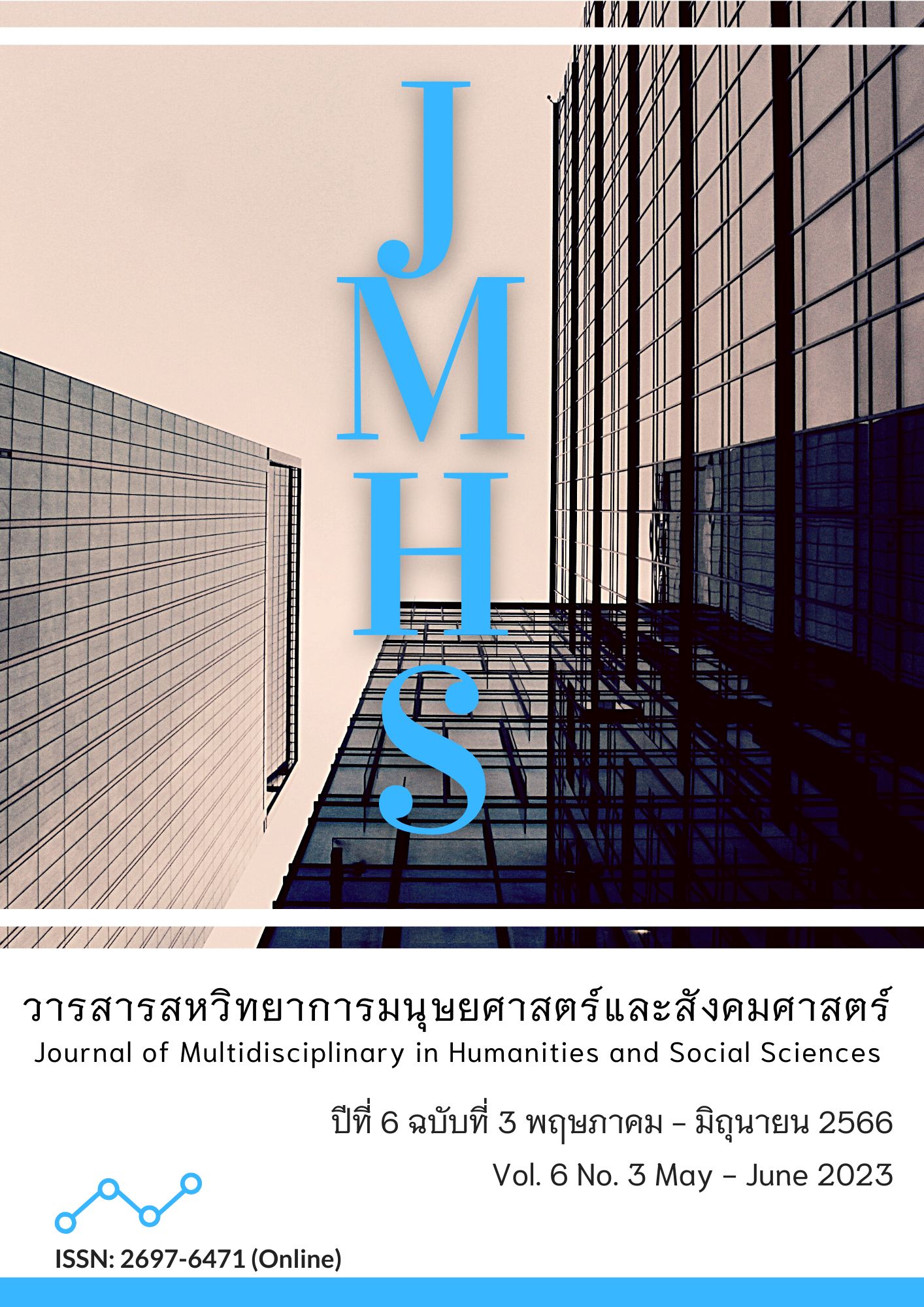The Development of an Application Assisted in Learning English for Communication in the High School Education for Visually-impaired Students in Thailand
Main Article Content
Abstract
There were obstacles to educate visually-impaired students (VIS) principally in learning English since the schools for the blind lacked of teachers, and educational facilities. Hence, the researcher developed the English for the Blind application, to 1) examine the students’ English competency; and 2) study the students’ satisfaction after using the application. The population was 99 VIS in grades 10 to 12 from 3 schools for the blind, chosen by simple random sampling. This study was quasi-experimental research, conducted from August to December 2021, collected data through baseline and endline surveys, pre- and post-tests, and the English for the Blind application, analyzed data by frequency, mean, standard deviation, and paired-samples t-test, and used the 5-point Likert scale and the score assessment criteria of the Common European Framework of Reference for Languages (CEFR) to interpret the scores.
The findings implied that the students in the experimental group who used the application could increase their English competency up to 3 levels from B1 Intermediate to C2 Proficient, whereas the students in the control group who did not use the application gained one level up. Moreover, the pre- and post-test scores of all students were significantly different. After the first experiment, the control group was let to use the application, and found that their final examination scores to the post-test scores of the previous experimental group was not different, meant that the English competency of VIS in the control group could improve after using the application too. The overall of the students’ satisfaction towards the application was satisfied, mostly with the contents and activities in each lesson which were appropriate for their levels, and the functions that supported their use. For this reason, the results indicated that the English for the Blind application was efficient and could develop the students’ English communication skills.
Article Details

This work is licensed under a Creative Commons Attribution-NonCommercial-NoDerivatives 4.0 International License.
Views and opinions appearing in the Journal it is the responsibility of the author of the article, and does not constitute the view and responsibility of the editorial team.
References
Anderson, A., & Lynch, T. (1996). Situational learning. United Kingdom: Oxford University Press.
Anderson, L. W., Krathwohl, D. R., & Bloom, B. S. (2001). A taxonomy for learning, teaching, and assessing: A revision of Bloom’s Taxonomy of educational objectives (Complete ed.). Longman.
Areerat, P. (2007). Development of educational software. Rajabhat Maha Sarakham University.
Armstrong, P. (2021). Bloom’s Taxonomy. Vanderbilt University Center for Teaching. Retrieved September 27, 2021, from https://cft.vanderbilt.edu/guides-sub-pages/blooms-taxonomy/
Bloom, B. S., Englehart, M. D., Furst, E. J., Hill, W. H., & Krathwohl, D. R. (1956). The Taxonomy of educational objectives, handbook I: The Cognitive domain. New York: David McKay.
Bornman, E. (2012). The mobile phone in Africa: has it become a highway to the information society or not?. Contemporary Educational Technology, 3(4), 278-292.
Brady, J. S. (2004). More than just fun and games?. Applied Clinical Trials, 13(11), 32-39.
Council of European. (2018). Common European Framework of Reference for Languages: Learning, Teaching, Assessment – Companion volume with new descriptors. Retrieved September 27, 2021, from https://rm.coe.int/cefr-companion-volume-withnew-descriptors-2018/1680787989
Department of Empowerment of Persons with Disabilities. (2017). The 5th National Plan for Life Development of Persons with Disabilities (2017-2021). Bangkok: Department of Empowerment of Persons with Disabilities, Ministry of Social Development and Human Security.
Department of Empowerment of Persons with Disabilities. (2021). Report the total number of with learning disabilities. Special Education Bureau. Bangkok: Department of Empowerment of Persons with Disabilities, Ministry of Social Development and Human Security.
Eberhard, D. M., Simons, G. F., & Fennig, C. D., eds. (2023). Ethnologue: Languages of the World (26th ed.). Dallas, Texas: SIL International.
Education Provision for Persons with Disabilities Act B.E. 2551. (2008). Government Gazette, 125(28A), 1-13.
Education Provision for Persons with Disabilities Act B.E. 2551. (2008). Royal Thai Government Gazette. Retrieved September 27, 2021, from https://www.krisdika.go.th/librarian/get?sysid=686515&ext=htm.
Gagné, Robert M. (1985). The Conditions of Learning and Theory of Instruction. New York: Holt, Rinehart and Winston.
Hossain, M. (2018) Exploiting Smartphones and Apps for Language Learning: A Case Study with The EFL Learners in a Bangladeshi University. Review Pub Administration Manag, 6, 241. doi:10.4172/2315-7844.1000241
Janwattanadachakhul, W. (2012). Transition in Educational System from High School to University for Students with Visual Impairment in Thailand(Master thesis). Ratchasuda Collage, Mahidol University.
Karsli, M. D. (2007). Egitim Bilimine Giris (Introduction to Education). Ankara: Pegem A.
Likert, R. (1932). A technique for the measurement of attitudes. Archives of Psychology, 22, 140, 5-55.
McLellan, H. (1995). Magical Stories: Blending Virtual Reality and Artificial Intelligence. In Imagery and visual literacy: Selected readings from the annual conference of the International Visual Literacy Association, 26, Tempe, Arizona.
Ministry of Education. (2008). Basis Education Curriculum (A.D. 2008). Bangkok: Kurusapa Ladprao Publishing.
Ministry of Education. (2010). Basis Education Curriculum (A.D. 2008). Bangkok: Kurusapa Ladprao Publishing.
Nattiya, S. (2019). The Development of the Class Management with Sound Application for Blind Learners. Rajabhat Maha Sarakham University.
Office of the Basic Education Commission [OBEC]. (2017). Learning areas of foreign languages, Basic Education Core Curriculum (A.D 2008). Bangkok: The Agricultural Cooperative Federation of Thailand Limited.
Sester Retorta, M., & Lopes Cristovão, V.L. (2017). Visually-Impaired Brazilian Students Learning English with Smartphones: Overcoming Limitations. Languages, 2(3), 12. https://doi.org/10.3390/languages2030012
Special Education Bureau. (2019). Manual for obtaining facilities, media, services and other educational assistance. Research and Development Group on Media Technology, Educational Facilities for Persons with Disabilities.
Vernon, M., & Andrews, J. (1990). The Psychology of Deafness: Understanding Deaf and Hard of Hearing Persons. White Plains, NY: Longman.


